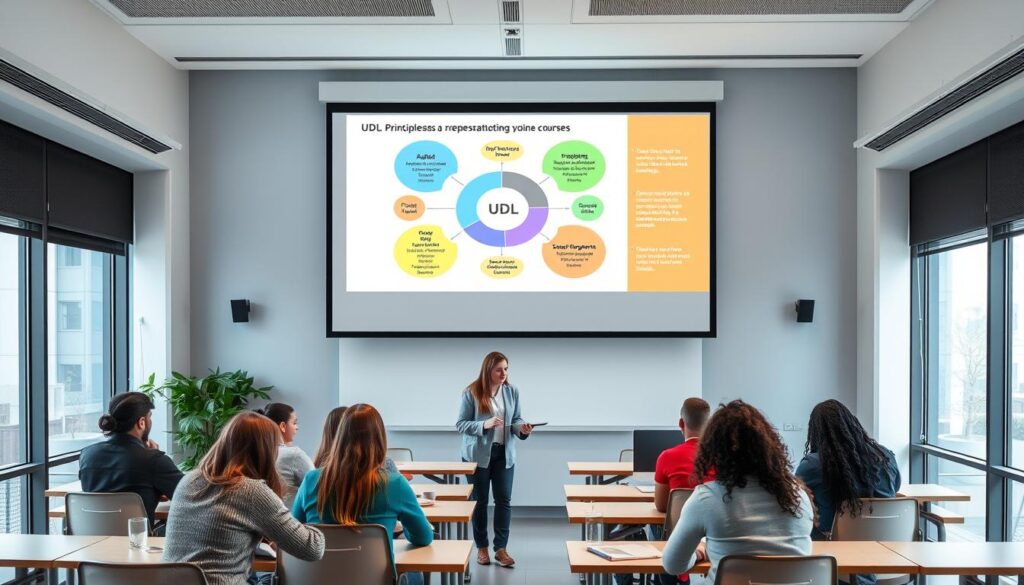Did you know that over 60% of students face challenges in online learning due to inaccessible content? This startling statistic highlights the need for a more inclusive approach. Enter Universal Design for Learning, a framework that transforms how we think about digital education.
Born from collaboration between CAST and Harvard, this approach ensures all students, regardless of ability, can thrive. It focuses on three core principles: representation, engagement, and action/expression. These principles guide educators in creating accessible, flexible learning environments.
The shift to digital learning during the pandemic exposed gaps in accessibility. Students with diverse needs often struggled to keep up. By adopting this framework, educators can address these challenges head-on. It’s not just about compliance—it’s about equity and inclusion.
Collaboration is key. Faculty, students, and tech partners must work together to implement these principles effectively. Tools like K12 online school platforms can support this effort, offering features that align with the framework’s goals.
Key Takeaways For Universal Design for Learning:
- Over 60% of students face accessibility challenges in online learning.
- Universal Design for Learning promotes inclusivity in digital education.
- Three core principles guide this approach: representation, engagement, and action/expression.
- Collaboration between educators, students, and tech partners is essential.
- Equity-focused teaching ensures all students can succeed.
What Is Universal Design for Learning (UDL)?
Education should adapt to students, not the other way around. This idea is at the heart of universal design learning, a framework that ensures every learner can succeed. It’s about creating flexible environments where all students feel supported.
The Origins of UDL
This approach began in 1984, developed by CAST and Harvard researchers. It was initially designed to remove physical barriers in classrooms. Over time, it evolved into a neuroscience-backed framework focusing on cognitive accessibility.
Inspired by architectural principles, it emphasizes that no “average learner” exists. Instead, it celebrates diversity in how students absorb and process information. This makes it a powerful tool for modern education.
Why UDL Matters in Modern Education
Today’s classrooms are more diverse than ever. Students come with unique strengths, challenges, and learning styles. A one-size-fits-all approach often leaves many behind.
This framework ensures that all students, regardless of ability, can thrive. It promotes accessibility and equity, making learning inclusive. By adopting this approach, educators can create environments where every student feels valued.
For more insights, explore how universal design learning transforms education.
The Role of Universal Design for Learning (UDL) in Online Education
Students thrive when learning environments adapt to their unique needs. This is where universal design shines, creating a framework that ensures no one is left behind. By addressing diverse challenges, it fosters an inclusive approach to education.
Breaking Down Barriers for Diverse Learners
Many students face obstacles in digital learning. Low bandwidth, shared devices, and neurodivergent needs are just a few examples. This framework tackles these issues head-on.
For instance, providing transcripts helps ESL students and those with hearing impairments. Tools like Blackboard Ally improve file accessibility, making content easier to navigate. These solutions ensure every student can succeed.
How UDL Complements Digital Learning Platforms
Digital platforms are more effective when paired with this approach. They offer features like flexible content delivery and interactive tools. This creates an environment where all students can engage meaningfully.
By integrating these principles, educators can design courses that cater to diverse needs. This not only enhances accessibility but also boosts student motivation and outcomes. For more on creating inclusive spaces, explore our focus on inclusivity and diversity.
Three Core Principles of UDL and How to Apply Them Online

Flexibility is the cornerstone of effective learning environments. By focusing on three core principles, educators can create experiences that cater to diverse needs. These principles—representation, engagement, and action/expression—ensure all learners can thrive.
Principle 1: Representation – Presenting Content Flexibly
Learners absorb information in different ways. Offering a variety of formats, like text, audio, and video, ensures everyone can access the material. For example, providing transcripts alongside video lectures helps those who prefer reading or have hearing impairments.
Using sans-serif fonts and adjustable background colors improves readability. Providing glossary documents for technical terms also supports comprehension. These small changes make a big difference in accessibility.
Principle 2: Engagement – Motivating Students in Virtual Spaces
Keeping learners engaged online can be challenging. Interactive activities, like polls or discussion boards, encourage participation. Gamification tools, such as badges or leaderboards, can also boost motivation.
Personalized feedback helps students feel valued. By incorporating their interests into lessons, educators can create a more meaningful connection. This approach fosters a sense of belonging and encourages active participation.
Principle 3: Action & Expression – Empowering Student Responses
Learners should have multiple ways to demonstrate their understanding. Offering choices, like written essays, presentations, or creative projects, allows students to express themselves in ways that suit their strengths.
Tools like voice-to-text software or mind-mapping apps support diverse expression methods. By providing these options, educators empower learners to showcase their knowledge effectively. For more insights, explore how these principles transform education.
Practical Strategies for Implementing UDL in Online Courses

Creating inclusive online courses starts with practical strategies. By focusing on accessibility and flexibility, educators can ensure all learners thrive. Two key approaches—chunking content and leveraging technology—can make a significant difference.
Chunking Content for Better Comprehension
Breaking down material into smaller segments improves understanding. Research shows that 6-9 minute videos are ideal for maintaining focus. For example, a 30-minute lecture can be divided into four 7-minute parts.
Using modular learning paths, like SCORM packages, helps organize content effectively. Adding extra examples or explanations ensures clarity. These practices make learning more manageable and engaging.
Leveraging Technology for Accessibility
Technology plays a crucial role in meeting diverse needs. Tools like screen readers and voice-to-text software support learners with disabilities. Formatting tips, such as using Arial font and yellow backgrounds, enhance readability.
Interactive features, like quizzes and discussion boards, encourage participation. By integrating these tools, educators can create a more inclusive environment. This approach ensures all students can access and engage with the material.
Overcoming Challenges in UDL Adoption
Adopting inclusive practices often comes with hurdles. Faculty and institutions may resist change due to lack of knowledge or time constraints. A TU Dublin survey found that 44% of educators cite limited time as a major barrier.
To address these challenges, collaboration across departments is essential. Creating a supportive environment where everyone feels involved can make a difference. Here are some strategies to ease the transition:
- Host “UDL Starter Workshops” with incentives like release time for participation.
- Share success stories, such as Northern Arizona University reducing accommodation requests by 31%.
- Form cross-functional task forces to promote shared principles and goals.
- Debunk myths, emphasizing that inclusive practices don’t lower standards.
- Provide pre-built LMS templates to save time and effort.
By focusing on these actionable steps, institutions can create a culture of inclusivity. For more insights, explore this research on effective implementation strategies.
Conclusion About Universal Design for Learning :
Adopting a universal design learning approach ensures every student thrives in any learning environment. This philosophy proved essential during the pandemic, offering flexibility and accessibility when traditional methods fell short. Zeina Abouchacra of D2L emphasizes the need for continuous improvement to meet diverse needs.
Start small by focusing on one principle, such as representation or engagement. Audit existing courses to identify gaps and implement changes gradually. Resources like CAST’s guidelines and Damian Gordon’s Top 10 Tips provide actionable steps for educators.
Looking ahead, applying these principles in STEM curriculum design will further enhance inclusivity. By prioritizing equity, educators can create spaces where all students feel supported and empowered to succeed.

